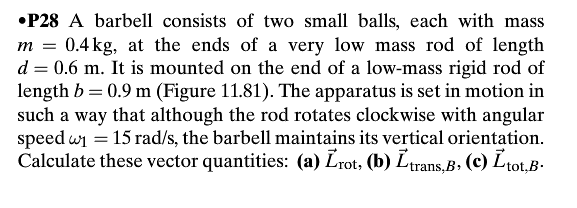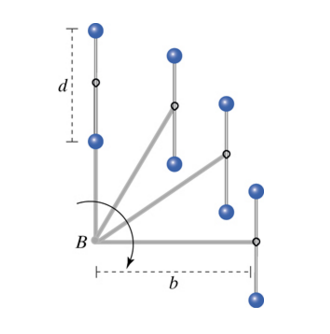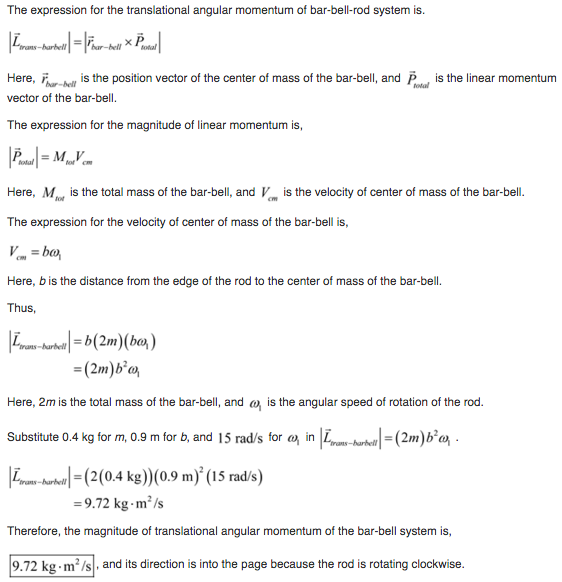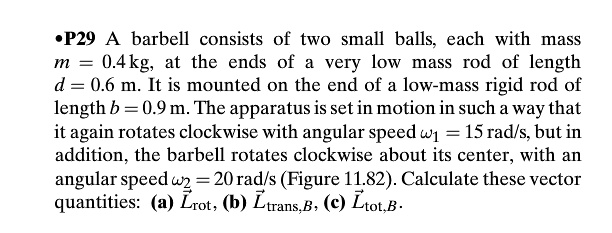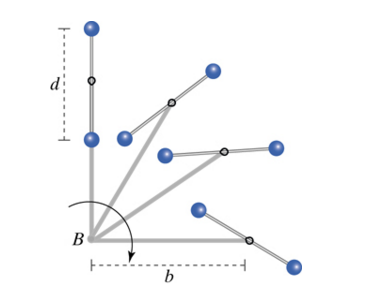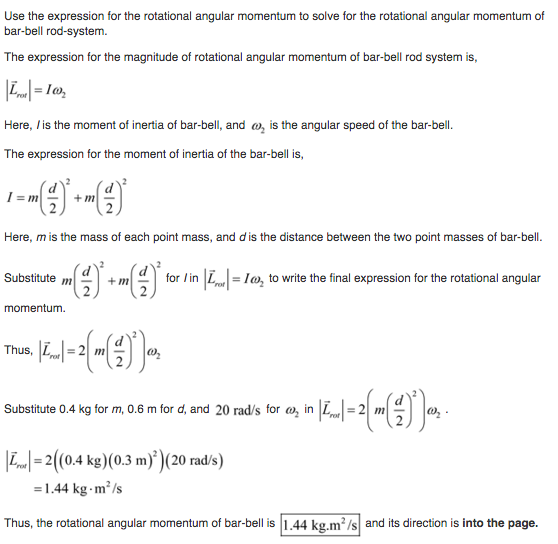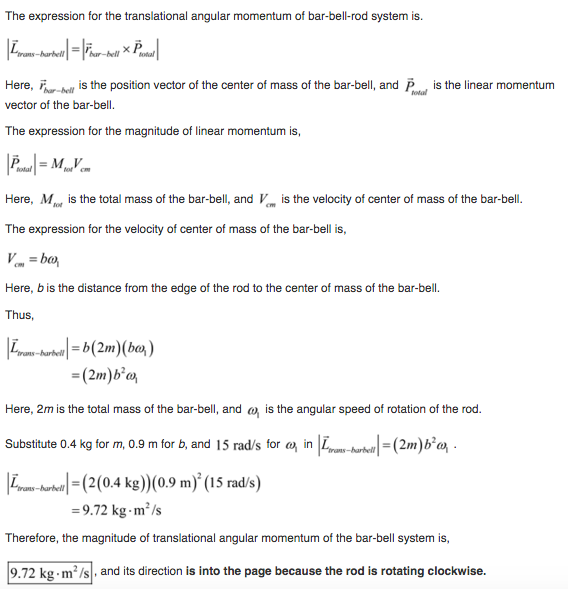Total Angular Momentum: Difference between revisions
Fatimajamil (talk | contribs) No edit summary |
Fatimajamil (talk | contribs) |
||
| Line 142: | Line 142: | ||
http://www.sparknotes.com/testprep/books/sat2/physics/chapter10section6.rhtml | http://www.sparknotes.com/testprep/books/sat2/physics/chapter10section6.rhtml | ||
Professor Gumbart [Georgia Institute of Technology] Lecture Notes | |||
[[Category:Which Category did you place this in?]] | [[Category:Which Category did you place this in?]] | ||
Revision as of 23:09, 25 November 2015
Work in Progress by Fatima Jamil
Total angular momentum can be expressed as ![]() . This page explains the breakdown of total angular momentum in these 2 components to help understand the difference between rotational angular momentum and translational angular momentum.
. This page explains the breakdown of total angular momentum in these 2 components to help understand the difference between rotational angular momentum and translational angular momentum.
The Main Idea
It is conveniant to break apart total angular momentum for a multiparticle system into rotational angular momentum and translational angular momentum. The translational angular momentum is associated with a rotation of the center of mass about some point A. This differs for different choices of the location of point A. The rotational angular momentum is associated with a rotation about the center of mass. The rotational angular momentum is independent of the location of the point A and the motion of the center of mass.
A Mathematical Model
It is often convenient to consider the angular momentum of a collection of particles about their center of mass, because this simplifies the mathematics considerably. The angular momentum of a collection of particles is the sum of the angular momenta of each particle:
[math]\displaystyle{ \mathbf{L}=\sum_i \mathbf{R}_i\times m_i \mathbf{V}_i }[/math] where [math]\displaystyle{ R_i }[/math] is the distance of particle i from the reference point, [math]\displaystyle{ m_i }[/math] is its mass, and [math]\displaystyle{ V_i }[/math] is its velocity. The center of mass is defined by:
[math]\displaystyle{ \mathbf{R}=\frac{1}{M}\sum_i m_i \mathbf{R}_i }[/math] where [math]\displaystyle{ M }[/math] is the total mass of all the particles.
If we define [math]\displaystyle{ \mathbf{r}_i }[/math] as the displacement of particle i from the center of mass, and [math]\displaystyle{ \mathbf{v}_i }[/math] as the velocity of particle i with respect to the center of mass, then we have
[math]\displaystyle{ \mathbf{R}_i=\mathbf{R}+\mathbf{r}_i\, }[/math] and [math]\displaystyle{ \mathbf{V}_i=\mathbf{V}+\mathbf{v}_i\, }[/math] In this case, the total angular momentum is:
[math]\displaystyle{ \mathbf{L}=\sum_i (\mathbf{R}+\mathbf{r}_i)\times m_i (\mathbf{V}+\mathbf{v}_i) = \left(\mathbf{R}\times M\mathbf{V}\right) + \left(\sum_i \mathbf{r}_i\times m_i \mathbf{v}_i\right) }[/math]
A Computational Model
How do we visualize or predict using this topic. Consider embedding some vpython code here Teach hands-on with GlowScript
Examples
These examples will help to solidify the difference between the different components of total angular momentum.
Simple
This simple example shows the importance of understanding the difference between rotational and translational angular momentum.
a) Calculate Lrot (both magnitude and direction)
b) Calculate Ltrans,B (both magnitude and direction)
c) Calculate Ltotal,B (both magnitude and direction)
Due to the fact that...
We calculated that our Lrot is zero, our total angular momentum is just based on translational angular momentum. So in this case, total angular momentum = translational angular momentum. So total angular momentum is 9.72 kgm^2/s, with the same direction, into the page.
Middling
This problem shows an example of total angular momentum being based off both translational angular momentum and rotational angular momentum.
a) Calculate Lrot (both magnitude and direction)
b) Calculate Ltrans,B (both magnitude and direction)
c) Calculate Ltotal,B (both magnitude and direction)
The total angular momentum is rotational + translational so it is <0,0,-11.16> kgm^2/s
Difficult
Connectedness
- How is this topic connected to something that you are interested in?
- How is it connected to your major?
- Is there an interesting industrial application?
Total angular momentum is very interesting to witness in the orbit of planets and satellites.
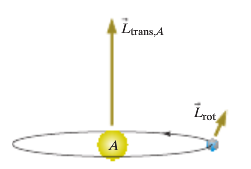
This image shows the translational angular momentum of the Earth (relative to the location of the Sun) and the rotational angular momentum (relative to the center of mass of the Earth).
It is also important to note that for point particle systems that there is no rotational angular momentum, and only translational angular momentum. This is important, because the total angular momentum for a point particle system is just simply translational angular momentum.
Understanding the topic of total angular momentum is extremely important in applying the conservation of angular momentum. Due to the fact that angular momentum is conserved, then it is important to note that if there is net force on some body directed towards a fix point, the center, then there is no torque on the body with respect to the center, and the angular momentum of the body about the center is constant. There is a very useful application of constant angular momentum, specifically seen in dealing with the orbits of planets and satellites. This concept is also used for the Bohr model of the atom.
History
Put this idea in historical context. Give the reader the Who, What, When, Where, and Why.
See also
Are there related topics or categories in this wiki resource for the curious reader to explore? How does this topic fit into that context?
Further reading
Books, Articles or other print media on this topic:
Elementary Theory of Angular Momentum (Dover Books on Physics) by M.E. Rose
Matter and Interactions by Ruth W. Chabay and Bruce A. Sherwood
External links
Internet resources on this topic:
http://www.phy.duke.edu/~lee/P53/sys.pdf
http://farside.ph.utexas.edu/teaching/301/lectures/node120.html
https://www.physics.purdue.edu/webapps/index.php/course_document/index/phys172/1332/135/9703
http://www.sparknotes.com/testprep/books/sat2/physics/chapter10section6.rhtml
References
https://www.chegg.com/homework-help
http://www.sparknotes.com/physics/rotationalmotion/angularmomentum/section1.rhtml
http://www.phy.duke.edu/~lee/P53/sys.pdf
http://farside.ph.utexas.edu/teaching/301/lectures/node120.html
https://www.physics.purdue.edu/webapps/index.php/course_document/index/phys172/1332/135/9703
http://www.sparknotes.com/testprep/books/sat2/physics/chapter10section6.rhtml
Professor Gumbart [Georgia Institute of Technology] Lecture Notes

